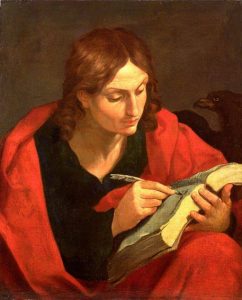Making Visible the Invisible
(1 Jn 1:1-4; Ps 97; Jn 20:2-8)
*****************************************
When a bishop is named, the tradition is to have the ordination on a feast day. So strong is that tradition that I, at the insistence of the nuncio, was ordained on August 29th, the feast of the beheading of John the Baptist!

Laying on of hands by my predecessor late Archbishop Peter Sutton
Today is the feast day of St. John, the beloved disciple. Let us pray that we may have some of that intimate relationship with Jesus that St. John had.

St. John
We know that John was involved in some of the central events of Jesus’ life, including the Transfiguration, the Crucifixion and the discovery of the Resurrection, as in today’s gospel. He is the disciple that Jesus loved and the one to whom Jesus confided the care of his mother Mary. He is mentioned in the Acts of the Apostles; later he was exiled to the island of Patmos, so he suffered for his faith in Jesus. He is said to have died at Ephesus. John wrote a Gospel, three Epistles and the Book of Revelation.
We are told in the Gospel he wrote that he leaned on the breast of Jesus at the Last Supper. Some spiritual writers say that gesture indicates he heard the heartbeat of Jesus, which gave him a relationship with Jesus unique among the apostles. While others like Peter and Paul were great preachers and thinkers, John’s relationship with Jesus was more emotional, intimate, and based on a felt love. Perhaps that is why Peter asked John to ask Jesus who it was who would betray him, and what would happen to John when Jesus appeared to the Apostles at the Lake of Tiberias.
John’s special relationship with Jesus shows up in his writings, which are also unique among all the writings of the bible. John is more of a mystic, and writes more of the miracles of Jesus, and of love, than all the other writers of the New Testament.
In the first reading today, John describes how Jesus was the Word of eternal life with the Father; that Jesus revealed that eternal life to us; that he saw and heard and touched Jesus; that he now had a deep and profound communion with God the Father, and wanted us to have that same communion with him, so that our joy may be complete.
The Gospel portrays John as the one who not only goes into the empty tomb after the resurrection of Jesus, but is also the first one to believe. What did he believe? It is like his special relationship to Jesus disposes him to understand more quickly than even St. Peter, what had happened to Jesus, that he had truly risen from the dead, and what that means for us in terms of new life, eternal life, the very life of God in heaven that he wants to share with us now.

Again, one of the best ways to cultivate that relationship with Jesus is Lectio Divina, contemplative prayer. In that ancient method of prayer, we prayerfully read the Word of God, then meditate on it, pondering it, studying it, asking ourselves what God is saying to us through that Word in our life today. We can then pray with those words for our needs and the needs of the world. Finally, we set it all aside and enter into the prayer of presence, like John, listening to the heart beat of the Jesus and the Father, attentive to the stirrings of the Holy Spirit within us.
John is the one who has the Bread of Life discourse instead of the Institution of the Eucharist. For John, the Eucharist is our daily manna that nourishes us today as God fed God’s people in their desert wanderings. It is probable that John’s community, more so than the others, celebrated the Eucharist everyday – the practice of most religious congregations. It is our intimate meal with the Lord and how privileged are those who can celebrate it daily.
So, as we celebrate this feast of St. John, the beloved disciples, let us pray that we may have that special communion with Jesus that John mentions in the first reading, through the Word of God, through the Eucharist, and our communion with the Church, the people of God, that begins with our baptism.




Bishop , your message mentions it all about St. John the Baptist what kind of person he is and his gospel is deep and detailed win his explanation about Jesus Christ and God the father. He is Jesus ‘ cousin that is why he is so related to him and believes in him. Thanks for sharing the picture of your ordination as an Archbishop. You have beautiful and outstanding pictures, especially art pictures. This is what I admire. You will always be in my prayers. Amen . Blessings!
I like the picture how of St. John reading and studying the literature and the other picture about Jesus dying on the cross. People praying for him after he is risen from the dead.